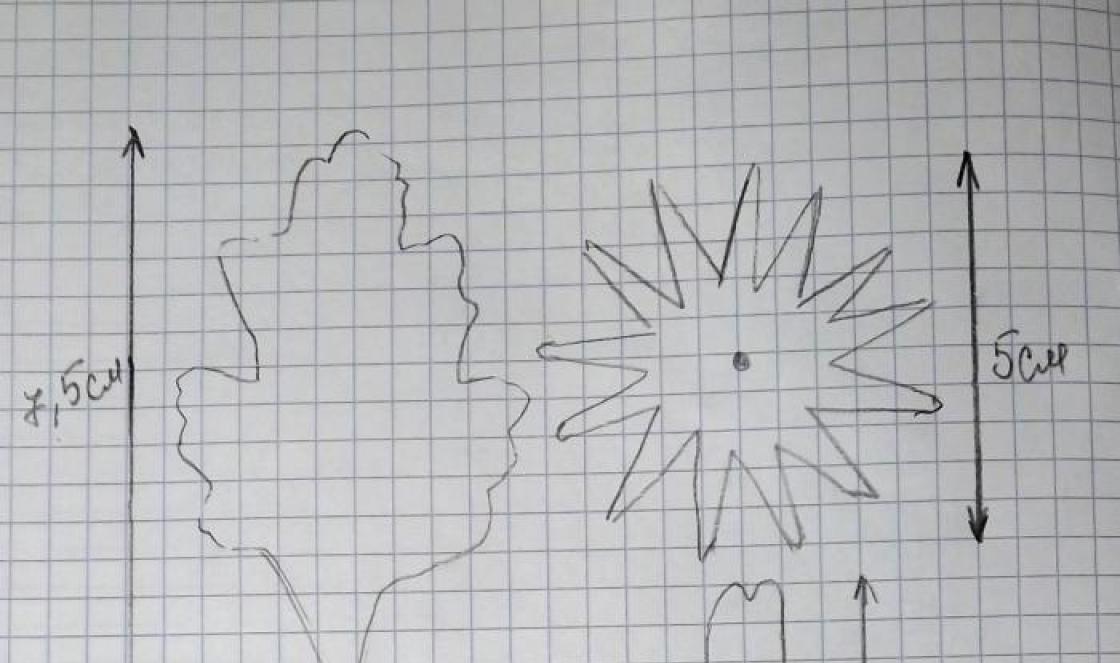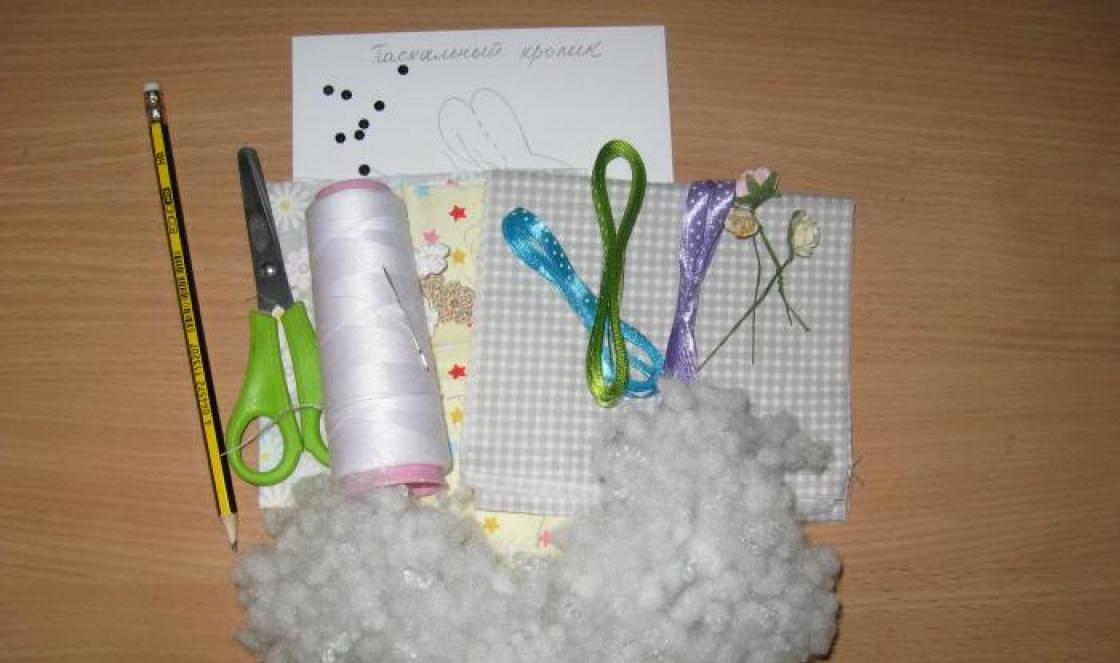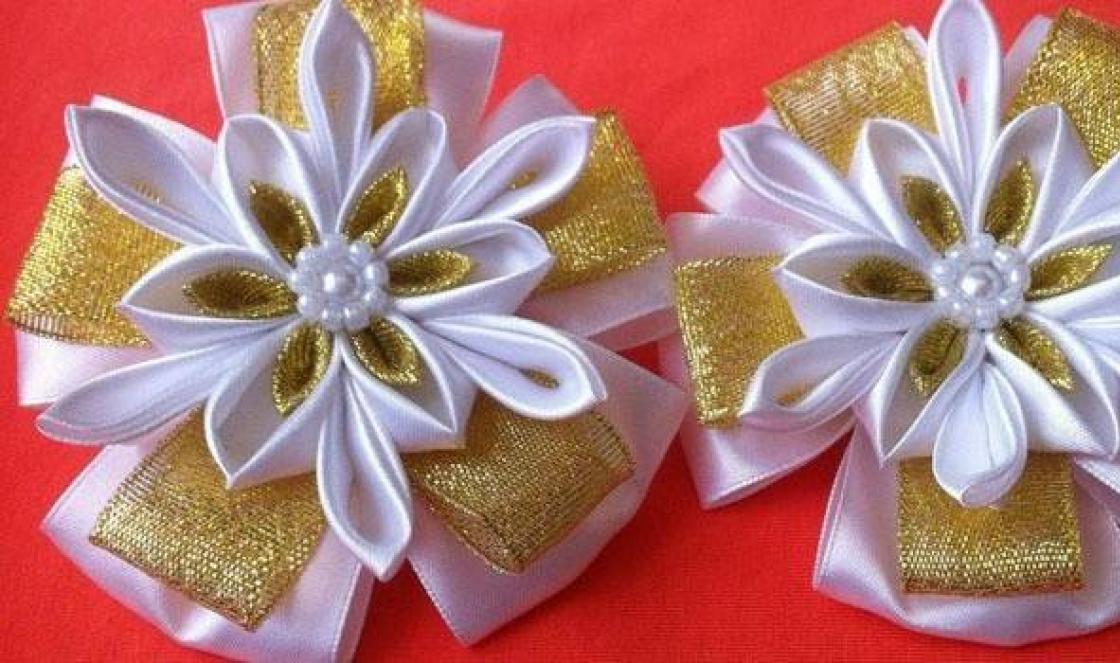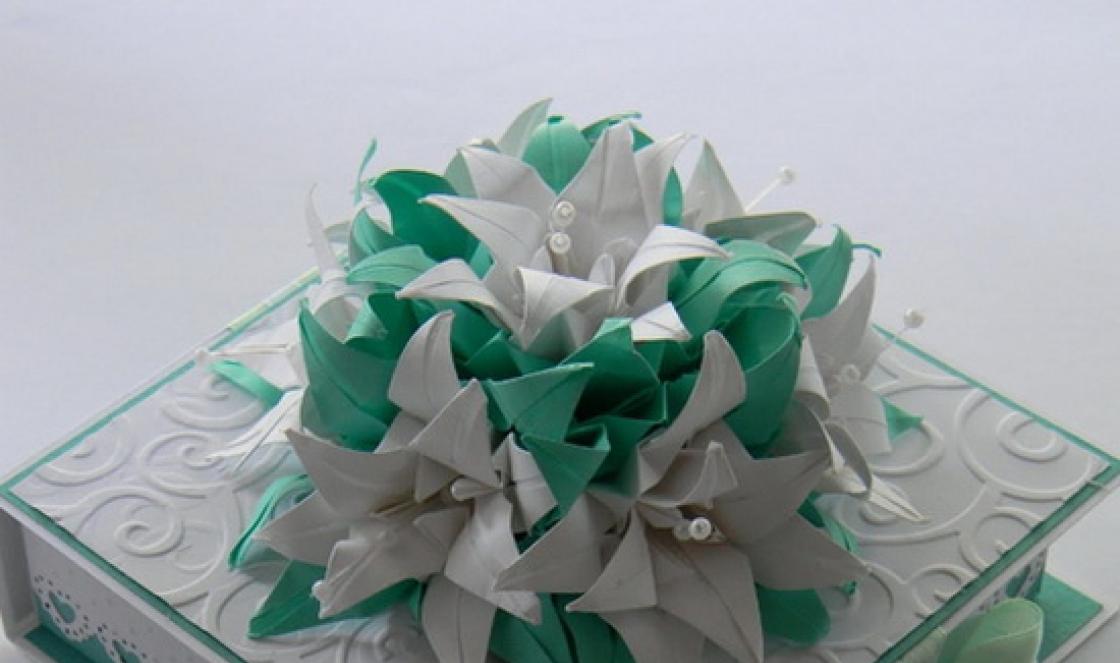Methods for folding the main petals, a couple of small tips, examples and diagrams. Nothing global, but I hope it will help newbies. It does not in any way claim to be the ultimate truth, just the methods that I use.
Materials and tools.
Real tsumami-kanzashi are made from natural silk, but, in principle, you can use pieces of almost any fabric you can get your hands on.
I usually use crepe satin, satin ribbons, nylon and organza.
U crepe satin a wide range of colors and, accordingly, it is easier to find a specific shade; squares of the required size are cut independently - there are no problems with petals of the same color and different sizes. It is soft - round petals are softer and easier to give the desired shape. To create sharp petals, the softness of crepe-satin is rather a minus - the blanks will have to be ironed when folding. However, it all depends on what kind of petal you want to get. One of the obvious disadvantages is that when scorched it turns black, so problems arise with light shades. If you don't care, it doesn't melt, it burns.
Organza- melts well, does not change color when melted. But it frays more than crepe satin and is easily deformed, so you will have to handle it very carefully.
Capron, has the same advantage as organza - it melts perfectly. However, unlike it, it does not crumble and is not deformed at all. It's very easy to work with, but it's very stiff and makes the round petals look awkward. But for spicy people it is quite suitable.
Satin ribbons- burn well, are almost not deformed, and are easily cut into squares. Stiffer than crepe-satin, but softer than nylon. However, problems may arise with finding the right shade and, especially, ribbons of the same color but different widths.
If you are just starting to practice kanzashi, I advise you to take a satin ribbon 5cm wide. The wider the tape, the larger the petal and the easier it is to work with. But, again, any fabric that doesn’t fray too much will do.
Beads, accessories, rhinestones, sequins And beads add to taste :)
You will also need needle and thread, scissors And tweezers- any long tweezers with a long pressing area at the ends will do. For example, medical, which can be obtained at a pharmacy. Or sewing - from handicraft stores.
To mark the fabric, a ruler, pen, white tailor's pencil or a piece of soap (for dark fabrics) will be useful.
Also you need candle for singeing the edges, pins And glue. The original kanzashi uses rice glue, it is not difficult to cook, but it takes a VERY long time to dry, and some skill in handling it is required. And mega-carefulness, so as not to dilute the pigskin when preparing and using it, which I have never managed :)
The fabric glue I use most often is Gütermann creativ - it has been tested many times in the rain and in the wash, sets quickly, holds tightly and remains transparent after drying. It glues fabric well to metal and plastic, holds sequins, rhinestones, etc. tightly. When you try to tear off a glued bead, the bead itself often breaks. And the tube is convenient - easy to apply a little at a time. Sold in craft stores. You can also use the Moment Crystal, it is cheaper and easier to find. But it is not so convenient to use, and when it dries, it sometimes turns white.
Sometimes, to make the flower stiffer, I use hairspray. Over time, however, the rigidity will disappear, but to fix the shape before assembly, before subsequent fixing with glue, this method is perfect. You can, of course, pre-gelatinize the fabric, but then you will get a hard fabric, which is not good for round petals. It’s easier to straighten the soft petal with your fingers and spray it with varnish.
On the other hand, the “storage” period depends on the fabric itself and the varnish used. I’ve been carrying a kanzashka made of satin ribbons sprinkled with blue Taffeta for six months now - and it still holds its shape and is noticeably stiffer than the others.
By the way, first try the varnish on a piece of fabric and let it dry completely - some fabrics change color after varnishing.
Many people advise storing the fabric already cut, but for me it is more convenient to cut the required number of squares for each specific job. Some fold the pieces with tweezers, others with their fingers.
In general, do what makes you most comfortable :)
If the fabric frays a lot, the edges of the squares can be carefully melted. Keep in mind, natural fabrics will burn, not melt! If you are using a candle, you should singe not at the tip of the fire, but closer to its base - where the flame is orange, quickly passing the edge of the square through the fire, and in some cases - nearby, without lowering it into the flame - this depends on the fabric itself and found out at random.
Sometimes, for the same purpose, I use glue for processing fabric sections, Prym Fray Check for example. But it makes the fabric stiff and sometimes causes it to change color.
There are two main petals - sharp and round. Most khan-kanzashi are made on their basis.
Let's start with the sharp petal.
Fold the square in half:
And again in half:
If you have soft fabric, and you want the petal to be very sharp, with a narrow edge, you can iron the folded piece.
And then, you won’t believe it, you need to fold it in half again:
If we now look at the folded square from the diagonal side, we have a sharp petal:
We cut the tip of petal “b” and singe it.
The type of flower you want - tall, low, with or without a slope - determines the position of the “a” line along which you need to trim the petal.
Flower with whole petals and petals trimmed along line “a”:
You can leave a hole in the middle of the petal, you can solder it tightly, you can not cut along the “a” line at all - it depends on the desired type of flower.
For example, this one has a hole left on the outer petals, and on the small, inner flower, the petals are tightly sealed:
If the fabric does not fray, it does not need to be scorched. But the scorched edges usually fuse and hold together, and to prevent the unscorched petal from unfolding, you will have to secure it with a pin. Set the finished petals aside.
Having made the required number of petals, we collect them on a thread and tighten them into a ring:
Mask the middle with a sequin or a cup for a bead - and the flower is ready. The number of petals and their sizes can be varied, obtaining different color options. Here, for example, three rows of trimmed petals are glued together in a pyramid, each next row consists of smaller petals:
And here, just petals of different sizes and colors:
To make a two-color petal, before the last bend, place one piece on top of the other, moving it down a little, and bend it one last time:
To make it easier, the square for the inner petal can be made 5 millimeters smaller than for the outer one.
Round petals.
Fold the square in half:
Now we add the extreme angles of the triangle to the middle one:
The folded corner can be stitched so that it does not fall apart during subsequent manipulations:
Turn the workpiece over and fold the side corners towards the center:
Fold in half so that the corners you just folded are inside:
Straighten the petal, secure it with a pin and drip a little glue onto the folded corners. Set aside and let it dry. You can spray it with varnish to better retain its shape. But then you will have to wait until the varnish is completely dry.
Having made the required number of petals, making sure that the glue/varnish is dry, cut off the hemmed corners and gather the petals onto a thread. Decorate and the flower is ready.
To make a double petal, place the second piece on top of the first after bending the square in half, and then fold their corners as one. As in the case of a sharp petal, the “inner” blank must be moved down a little, or made from squares smaller than the squares for the outer petal.
That's all.
Create, combine and create.
Good luck to you.
You may have already seen amazing hair and clothing decorations made from silk flowers. This beauty has a name - KANZASHI TSUMAMI.
Hairpins and combs are traditionally used in Japanese hairstyles, but nowadays jewelry using the Kanzashi technique has gained its popularity far beyond Japan. The so-called “kanzashkas” now serve not only as hair decorations, they are used to make brooches, use them as interior decoration, etc.


Candlesticks using Kanzashi technique

Box using Kanzashi technique
If you figure out how to do Kanzashi, it becomes clear that it is not at all difficult.
Materials and tools
In order to make products using the Kanzashi technique, you will need the following materials and equipment:
You can cut fabric or ribbons with scissors or with a soldering iron. To do this, we need a surface on which to cut. It could be an old unnecessary kitchen board, but I preferred regular wall tiles (left over after renovation), the soldering iron does not burn them and they are easier to clean. Some petals can be burned with a candle or lighter.
It is better to use glue that is thick and transparent so that it does not leave marks after drying. I opted for “Moment-gel”: transparent, does not flow, adheres well.
Many people advise using tweezers when rolling petals.
I use tweezers when burning fabric over a candle.
- satin ribbons of any size, optimally 5 cm and 2.5 cm, but you can take any fabric: silk, satin, organza, etc.
- ruler
- pencil or chalk for marking even squares
- scissors (any kind, as long as they are sharp)
- lighter and candle or soldering iron (if you know how to use it)
- Moment-gel glue or hot glue gun
- tweezers (preferably long)
- long and thin needle
- strong thread (for example, monofilament)
- beads, sequins and all sorts of beautiful little things
I think over time you will decide for yourself how and what is more convenient for you to work.
Types of Kanzashi petals
The Kanzashi technique is as follows: many small even squares of fabric are folded in a certain way and assembled into a flower. The petals themselves are sewn or glued together.
No matter how strange it may sound, there are only 2 types of kanzashi petals: round and narrow, and the rest is up to your imagination.
Using this flower as an example, we will learn how to fold narrow and round petals:

Narrow kanzashi petal - master class
We use the same materials and tools as listed above.

Using a soldering iron or scissors, cut into even squares. I have a satin ribbon 5 cm wide, which means the squares are 5 by 5 cm. Their number depends on the size of the flower that you will collect. There are 7 yellow and 5 green.

It is often recommended to roll the leaves using tweezers. To be honest, I find it more comfortable with my fingers, but this is what you prefer.
Fold it into an even triangle. The fold itself is at the top.

We apply the right corner of the triangle to the left.

And fold it again in the same way, from right to left. Align the folds.

Trim the ends of the fabric evenly:

And we burn it a little over a candle, fastening the edges at the same time. This is done like this: holding the edges with tweezers, quickly move the petal over the flame.

It is better to burn at the very bottom of the fire, then the fabric will melt and not burn.
We also cut off the lower edges and melt them. Here you can not glue them together, but simply melt the fabric so that it does not crumble.

Here's what we got:

Rear view
Using the same principle, we roll up the remaining green leaves.

For clarity, watch a video master class on narrow Kanzashi petals:
Front view
Round kanzashi petal - master class
We fold the yellow square into a triangle.

Now we collect the side edges in the middle, towards the bottom corner. The folds are made from the top and sides.

We pull the side corners back and check that the edges are folded evenly.

We also cut off the ends and melt them.

We also trim the bottom edge evenly and melt it.

Only here the edges must be burned and be sure to be glued together.
While the fabric is warm, I simply pinch the edges with my fingers.
This is what we got. From this side, drip a little glue inward and glue the leaf together.

Rear view

Front view
These are the blanks we got. Here you can clearly see where the yellow petals stick together.

In the video master class, you can watch again how round petals are made, and also learn how to assemble beautiful hair ties:
How to make kanzashi flowers
Let's start collecting kanzashi flowers. We string the yellow petals onto a needle and thread. I prefer monofilament because it is not visible.

And we tie it into a flower like this:

We cut out circles from cardboard and tape, place a cardboard circle on the tape, and generously coat it with glue.

And, tucking the edges, glue the fabric to the paper. Let the glue dry a little and coat the surface with glue again.

Then we glue the blank to the flower from the back side.

Here it is better to use glue rather than a glue gun. Since our flower is voluminous, it is very difficult to glue it evenly right away. And while the glue dries, you can adjust the leaves to make it even. It’s difficult to do this with a glue gun - the glue hardens very quickly and it’s quite problematic to peel it back off.
Here's what we got:

Apply glue to the tip of the green leaf (here I use a glue gun)

And connect it with the second leaf.

We make two double leaves.

We also lubricate the single leaf with glue and glue it between the two already connected leaves.

In the same way, we glue three leaves to the double one.

This is what the branch should look like:

Apply glue to the tip of the branch

And glue it between the leaves of the flower.

Glue a bead or rhinestone into the center of the flower.

This kanzashi flower can be used to decorate a brooch, a hairpin, or a hair tie. And if you get a little creative, you can create a lot from the 2 simplest kanzashi petals!
Categories Kanzashi petals made of satin ribbons (photo)Kanzashi petals made of satin ribbons (photo)
Surely, you have more than once come across types of products using the kanzashi technique that decorate accessories, clothes and hairstyles. This traditional handicraft came to us from distant Japan and has taken a worthy place in the hearts of craftswomen. Now Kanzashi products are used in different directions.
Before making a beautiful flower of any shape or with a curl, you need to master the knowledge of how to make kanzashi leaves and kanzashi petals. This master class (mk), which is also suitable for beginners, will clearly show you new ideas and types that can be done with your own hands. 





Required material

In order to properly make leaves from ribbons with your own hands, you need to select the necessary accessories:
- several shades of satin basma;
- ruler;
- a simple pencil;
- small scissors;
- flame of a candle or matches;
- glue;
- tweezers;
- needle and thread;
- beads for decoration.
We will look at several ways to create a kanzashi petal from satin ribbons. There are only two of them, these are round and pointed petals. From these, we will make an elegant flower with our own hands.
Making a narrow petal from ribbons
Prepare all new materials on your workbench. We start by cutting the satin ribbons into small squares. We should have seven pieces of yellow and five pieces of emerald color. 
If you feel uncomfortable picking up the flap with your fingers, use tweezers. Fold the piece of tape so that the fold is at the top, as in the photo. 
Connect the right corner to the left. 
Do this action again. Align the folds. 
Using small scissors, trim the ends as shown in the photo. 

Scorch this edge with fire; we do such manipulations very quickly so as not to burn our future petal for beginners.
Also pour fire over the edges that are located below. This is not done for gluing, but to prevent the threads from fraying. 

Look at the photo, such a blank should work for you too. 
In exactly the same way, we create subsequent elements.
In order to learn in detail the technology and types of creating kanzashi petal, you can study the video master class (mk) on our portal.
Video: Making a narrow petal
Round petal using kanzashi technique
Kanzashi round petal is made step by step, almost the same as in the previous master class.
Fold the yellow flap in half. 
Attach the ends that are located on the sides to the bottom. You will get all the side folds, as in the photo. 
Pull the edges back and make sure they are even. 
Trim the edges and scorch with fire.
The edge located below is also removed and burned. In this case, we not only singe the edges, but also glue them together. While the cut is still hot, press the ends together with tweezers. 


This is the inverted petal we have, look at it from both sides. 

The photo shows the blanks that are obtained as a result of our work. This means the master class (mk) is going well and what we do with our own hands works out. A detailed lesson and master class can be viewed in the video. 
Video: Round petal master class
Assembling a flower from different petals
Now all our blanks from satin ribbons, which we made with our own hands, need to be put together.
Pick up petals, yellow
on a thread. 
Build such a product. 
From thick cardboard, you need to cut out a small circle. Place it on the fabric, while covering it with textile glue.
After tucking in the ends, glue the tape onto the cardboard. Wait until this element dries and re-soak it again. 

Glue the stitched flower to our element. 
While the textile glue dries, you can straighten the round kanzashi petals with your own hands. Our master class (mk) continues. Let's start making the craft further. Look what happens after we made the inverted petal. 
Take a green kanzashi petal and drop a drop of glue on it. 
Attach the next sharp petal to it. 
We make sharp petals in two pairs, two in each pair. 
We soak another sharp petal with glue and attach it between the two primary crafts. 

Using exactly the same steps, we attach three things to the double petal.
The photo shows a twig and sharp petals on it. 
Place a drop of glue on the twig. 
Attach it between the round yellow petals.
The core of the flower can be decorated with any decorative material, such as beads or rhinestones. This master class (mk) is also completed, you can watch it on the video located on our portal. 

These petals are useful as decoration for any accessory.
Kanzashi petals with curl
Our small master class will show you how to make a sharp petal with a curl. We will need not much material, namely:
- pink and black satin ribbon;
- glue;
- scissors and tweezers;
- fire from a candle or lighter.
You need to cut the satin ribbons into small squares; this procedure will be clear even for beginners. Their size will be equal to five centimeters. 
Fold the piece of tape in half to create a triangle. Then roll it up one more time. 

Do the same with the black color of the workpiece. Place one element inside the other so that the pink piece is inside the black one. 
Using tweezers, wrap the end of the triangle into the middle, grabbing two colors of ribbon at once. 
Connect the edges of the product together. And spread the top of different colors to the sides. 
Cut off the excess edge and scorch it with a flame of fire. Thus, we got an interesting petal with a curl in the middle.
Such sharp petals with a curl will turn an ordinary headband or headband into an exquisite evening accessory. This kanzashi technique is becoming more and more popular among all fashionistas who prefer things made with their own hands. These flowers are also used to make hairpins and brooches that adorn beauties. It is important, before starting work, to watch videos of some types of petals that other needlewomen make in order to decide what kind of accessory you want to make.
Video: Petals with curls





